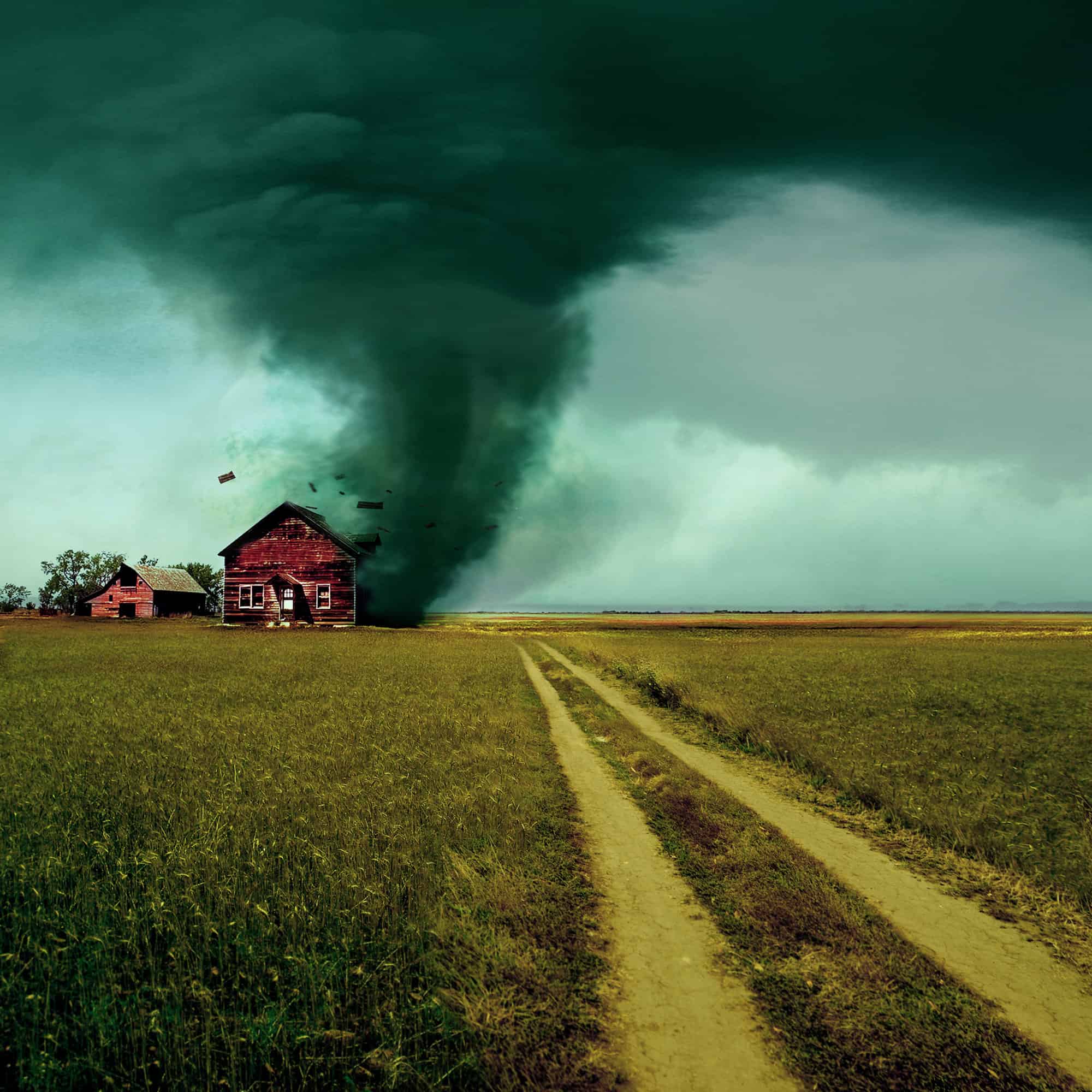Imagine a raging thunderstorm. The sky grows black, the low clouds begin rotating, and you hear the blare of a tornado siren. The funnel touches the ground, and you hear that awful “freight train” sound so often synonymous with tornadoes. The exact tornado-causing weather conditions have come together. You have minutes, if you’re fortunate, to get someplace safe. But where?
Tornadoes are devastating natural disasters that take hundreds of lives and destroy millions of dollars’ worth of property every year. The risk of dying in a tornado is actually quite low, but with some knowledge and preparation, you can make those odds even lower. This article will describe the most common weather conditions that spawn tornadoes and what you can do to protect yourself and your family.
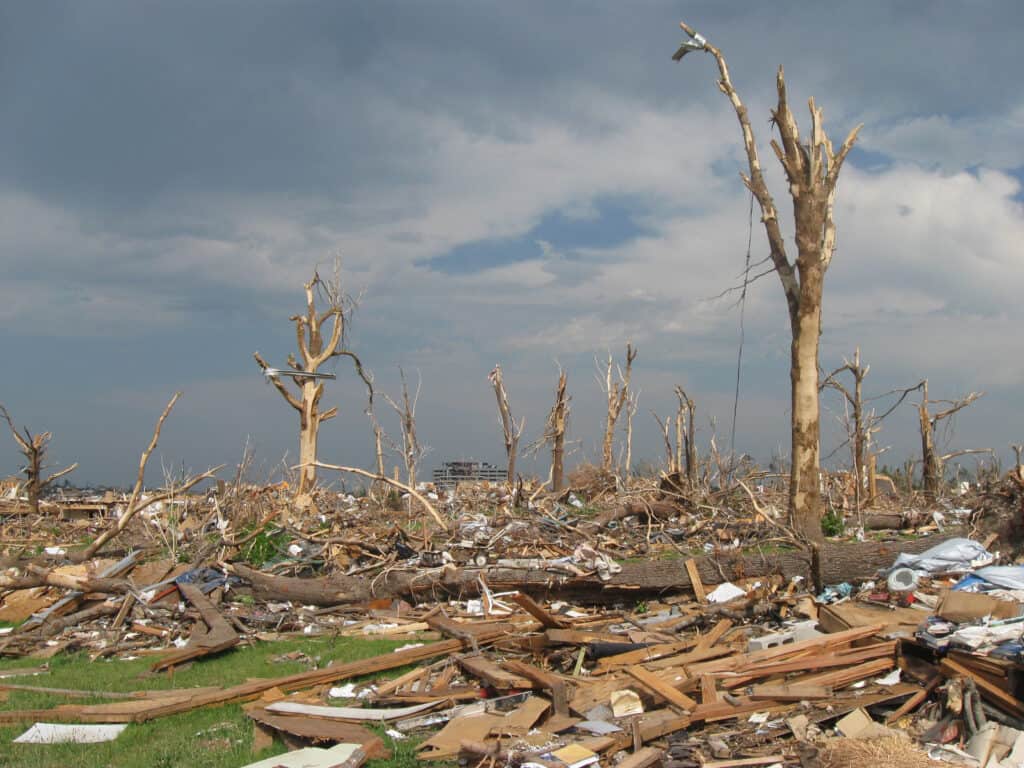
The 2011 Joplin, Missouri tornado killed 158 people, injured 1,150, and accrued $2.8 billion in damages.
©Melissa Brandes/Shutterstock.com
What is a Tornado?
What do tornadoes look like? They can be anything from skinny little ribbons that may dance and loop around each other all the way to huge funnels over a mile wide that just look like a wall of blackness moving over the landscape. Tornadoes can be invisible if they have not begun to pick up very much dirt yet. They can be misty and blue if they form over water and start lifting it into the air. These are waterspouts. Fire tornadoes are also possible when a forest fire generates so much heat it starts forming its own weather pattern. Flames are pulled up in a funnel-shaped updraft of air.
But what exactly is a tornado? It’s a rotating vortex of air that pulls up soil, plants, wreckage, and living things from the earth and flings them in every direction. Tornadoes are typically about 900-1500 feet wide, but can be over a mile wide. They can travel up to about 50 miles, at a rate of anywhere from 10-50 mph, which means you can’t count on outrunning it, even with a vehicle, in stormy conditions, poor visibility, and a debris-strewn road. Inside the funnel, the wind speed can reach up to 500 mph, much faster than the strongest hurricane winds ever recorded.
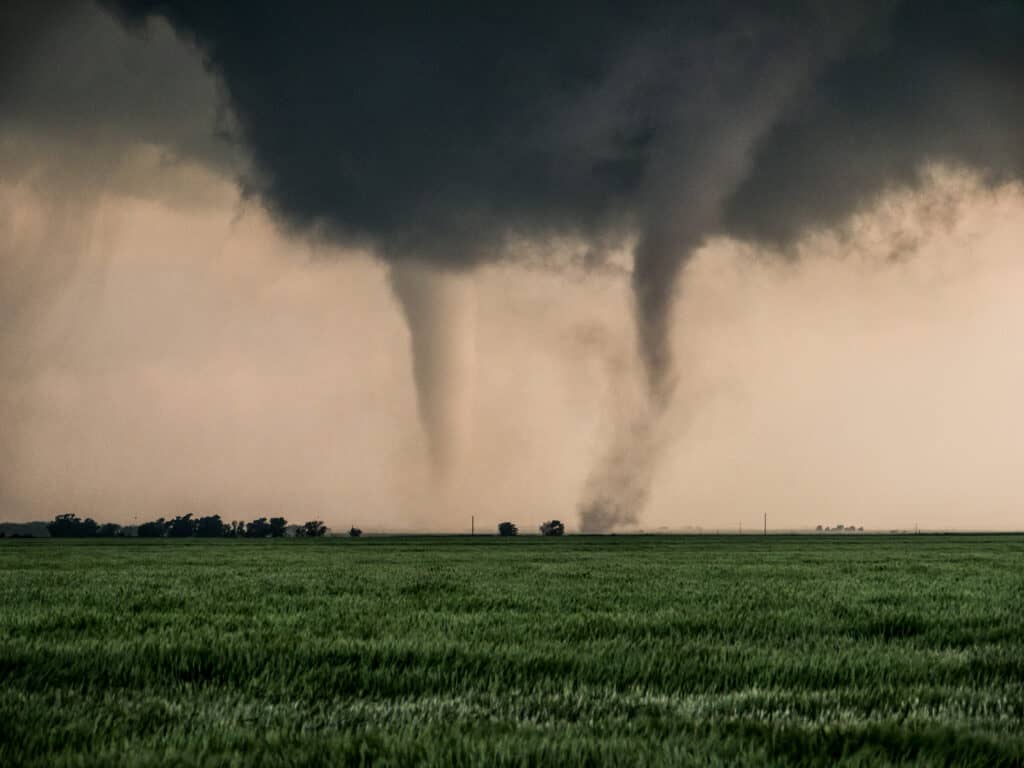
Some tornadoes have more than one funnel that revolve around a common center.
©Eugene R. Thieszen/Shutterstock.com
Which Countries Have the Most Tornadoes?
The United States has the most tornadoes of any part of the world, mostly in an area known as “tornado alley” stretching through the prairie lands in the center of the country, from Texas north through the Dakotas and into southern Canada. The United States has about 800 tornadoes a year, with Canada coming in second place at just about 60 a year. Just a few dozen happen each year in other countries such as the United Kingdom, New Zealand, Japan, Australia, India, Bangladesh, South Africa, and Argentina. Tornadoes anywhere else are exceedingly rare.
How Tornado Strength is Measured
The Enhanced Fujita Scale or EF Scale, is used to classify tornadoes based on their estimated wind speeds and the damage they cause. Here’s what the scale looks like:
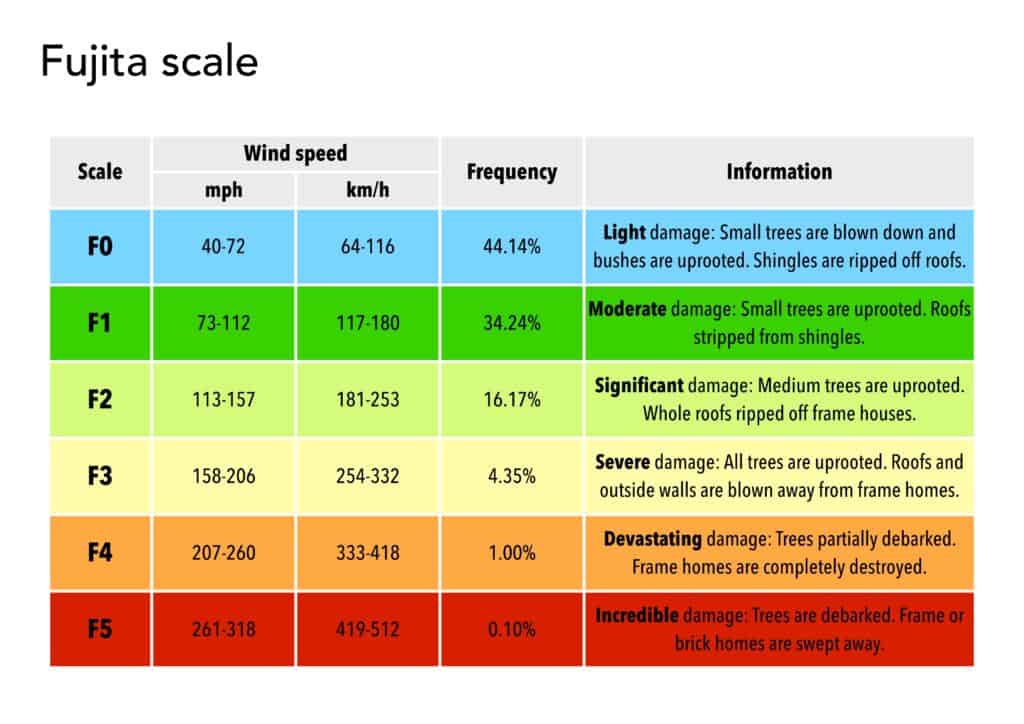
The Fujita tornado intensity scale measures tornadoes based on windspeed and the damage they cause.
©Dimitrios Karamitros/Shutterstock.com
What Are the Usual Weather Conditions for a Tornado?
Tornadoes are the result of a collision of warm moist air near the Earth’s surface with cool, dry air higher in the atmosphere. This creates instability that can begin to rotate into a violent column of air with a powerful updraft that can pull soil and debris up into the air. Tornadoes usually happen in the spring and summer. The weather patterns are changing then, and the atmosphere gets more unstable and stormier. Another time you may experience a tornado is during a hurricane. For example, in 1976 Hurricane Beulah came ashore in Texas from the Gulf of Mexico and set off 148 tornadoes. Tornadoes that come with hurricanes often come ahead of the path of the hurricane. Here’s what things might look like from the ground level as a tornado forms:
- Severe thunderstorms with frequent thunder and lightning.
- Large, dark, low-lying clouds.
- An extremely dark sky, sometimes with green- or yellow-tinted clouds.
- Heavy rain and large hail.
- A distinctive rumbling, whistling sound that’s a lot like an approaching train.
- Clouds beginning to show rotation.
- A funnel cloud forming below a thundercloud.
- An approaching cloud of debris.
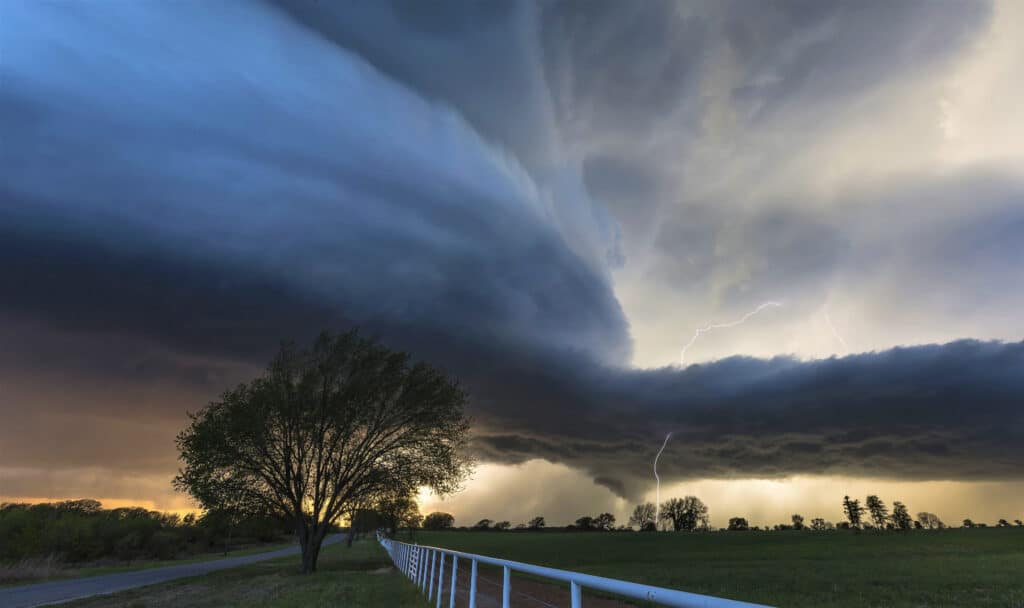
A severe thunderstorm with dark, low clouds, heavy lighting and thunder, and large hail are some of the weather conditions for a tornado.
©artofvisionn/Shutterstock.com
What’s the Difference Between a Tornado Watch and Tornado Warning?
It’s really easy to mix these up, but you need to memorize the difference between a tornado watch and a tornado warning. Different actions are needed for each one to keep you and your family safe.
Tornado Watch
A tornado watch is like a yellow traffic light: WATCH OUT for a possible problem. The conditions for a tornado are developing and a tornado could materialize in the coming hours. Pay attention to weather reports and make sure you’re ready if the weather takes a turn for the worse.
Tornado Warning
A tornado warning is like a red stoplight: WARNING! Stop whatever else you’re doing and pay 100% attention to safety. A tornado warning means one has been spotted outdoors, or detected on weather radar. At this point, you will hear tornado sirens going off and must take immediate action.
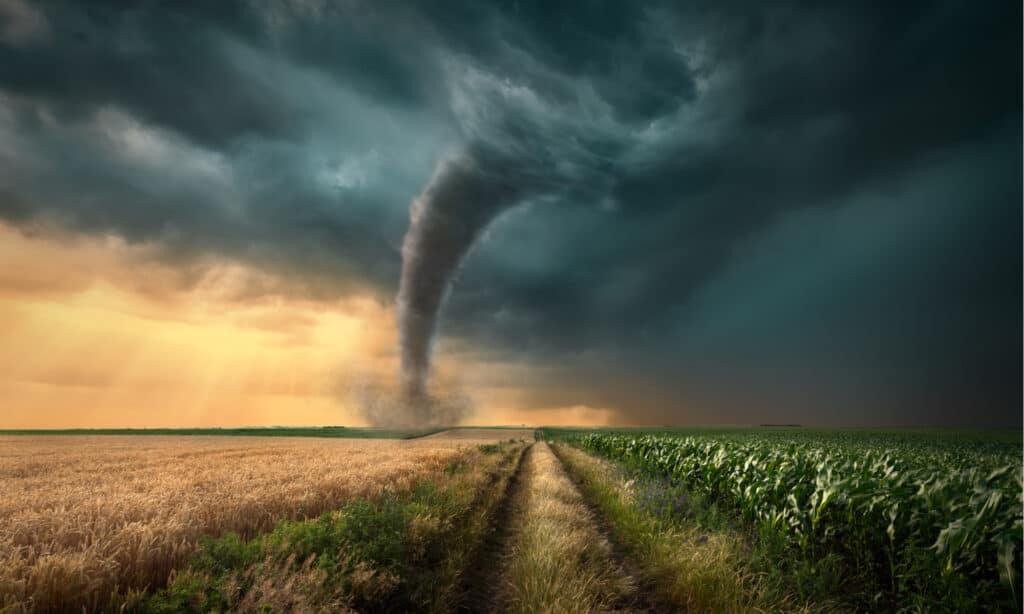
A tornado warning means a tornado has been sighted on the ground or on radar and you need to take shelter immediately.
©Rasica/Shutterstock.com
What to Do During a Tornado Watch
- Keep family members and pets close by.
- Remind everyone where in the house you will shelter if things get worse.
- If there is clutter in or around your shelter space, such as storage boxes, get them out of the way.
- Make sure you have flashlights, water, a radio, and spare batteries.
- Make sure your emergency supplies such as flashlights, water, and batteries are accessible.
- Stay away from windows and keep them closed to protect yourself from glass and debris.
- Follow the media for updates on the developing weather conditions for a tornado.
- Even if there is no tornado, these are reasonable precautions even in a bad thunderstorm.
What to Do During a Tornado Warning
If you are indoors:
- Follow the same procedures as a tornado watch, only immediately get yourself, your family, and nearby pets into your shelter. Do not take time to search for missing pets as you could have just minutes to get to safety.
- If you don’t have a storm cellar, go to a windowless lower floor of your house, under a staircase, in a closet, in a bathtub, or under a table or workbench, or other sturdy furniture.
- Cover your family with mattresses, sleeping bags, or protective blankets. Get your kids to wear their bike helmets or football helmets if they have any.
If you are outdoors:
- Get inside a substantial building if possible. Stay on the lowest level, in an interior room. Resist the urge to look out the windows, as flying glass and debris are the most probable way of getting hurt.
- If there’s no building close enough to run to, lie down in a ditch or other low place and cover your head with your arms.
- Stay away from trees as much as possible to keep from getting pelted with flying branches and splinters.
- Don’t try to outrun a tornado in your car. Don’t shelter under a bridge or overpass. They force the wind into a small space and make it faster.
- Don’t shelter in your car. A tornado can easily pick it up or flip it. Get out and lie down in a ditch and protect your head with your arms.
- If you don’t have time to get away from your car, get your seatbelt as tight as you can, duck below window level, and use your arms to protect your head.

Cars are not safe shelters from tornadoes. Get out and lie down in a ditch instead.
©Judy Kennamer/Shutterstock.com
What Should You Include in a Tornado Emergency Kit?
If you live in a place that tends to have a lot of tornadoes, you really need to have an emergency kit ready at all times. And it’s not just to survive the tornado itself, but to provide for essential needs if you are trapped in your shelter for hours or days waiting for rescue from a particularly large disaster. But even if you don’t live in tornado alley, a kit like this is useful for other types of emergencies as well.
- Bottled water – each person in the shelter will need a gallon of water a day, and you want to plan for up to 3 days.
- Canned or dried food – think canned tuna, crackers wrapped in plastic, etc. Choose things that don’t need to be refrigerated or cooked and enough for each family member to eat for three days.
- Baby food or infant formula, if necessary.
- A manual can opener.
- Utensils
- Pet food and water for three days.
- Toilet paper, unopened and wrapped in plastic to protect from dripping water.
- A battery-powered radio.
- Flashlights
- Extra batteries for the radio and flashlights.
- Prescription medications.
- A first-aid kit.
- Charged-up auxiliary power source for your cellphone.
- Blankets, pillows, warm coats
- A waterproof sheet of plastic to help keep you dry if your shelter is damaged and leaking.
What to Do After a Tornado
- Don’t let members of your family scatter. Stay together until help arrives.
- Watch out for downed power lines. Don’t step in puddles of water. Electricity can travel a long distance through wet ground
- Be careful where you step. There might be a lot of sharp fragments on the ground.
- Don’t go back into damaged buildings. They may collapse at any time. Wait outside at a safe distance for rescue.
- There may be gas leaks so do not use matches or lighters.
- Listen to the radio and follow instructions. Let emergency crews work, and do what they tell you to do.
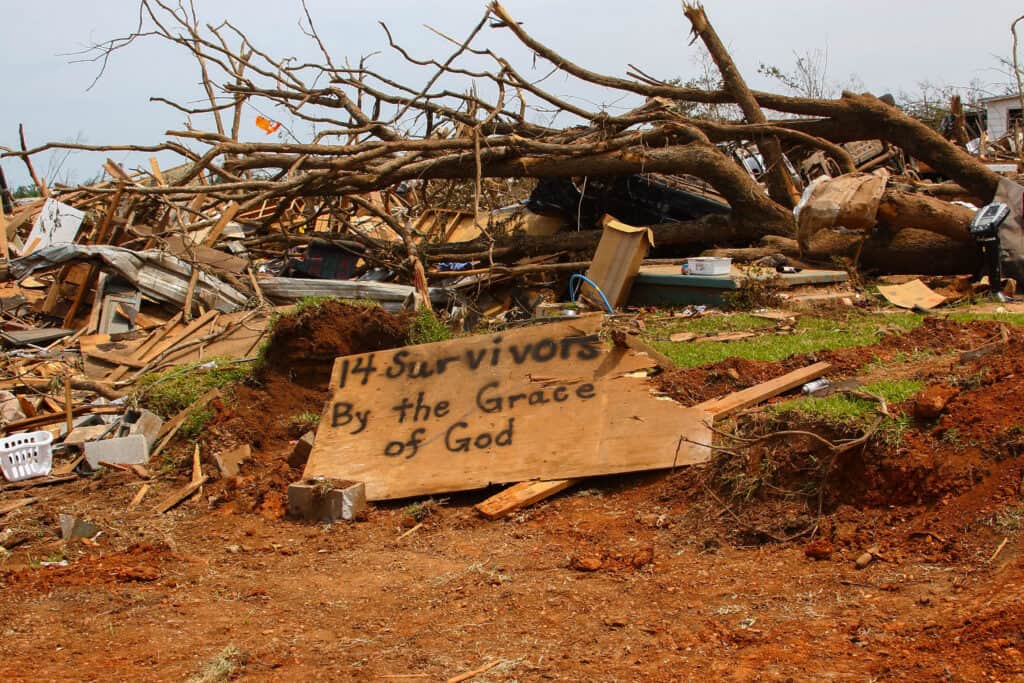
Be careful after a tornado, as there can still be danger from fallen power lines, gas leaks, building collapses, and broken glass.
©Gregory Simpson/Shutterstock.com
You Can Survive a Tornado
Despite all this, tornadoes are still pretty rare events, and 99% of people who experience them survive. You’re far more likely to die from ordinary things like driving a car, falling off a ladder or down a staircase, having a poor diet, or even from having a coconut fall on your head. Just a little bit of awareness of the likely weather conditions for a tornado and a little bit of advance preparation can help make sure you are never part of that unfortunate 1%.
.
Thank you for reading! Have some feedback for us? Contact the AZ Animals editorial team.

